Japan
Wood Products Prices
Dollar Exchange Rates of 10th
May
2021
Japan Yen 108.84
Reports From Japan
Country struggles to contain
fourth wave of infections
Japan put in place a third state of emergency in Tokyo and
some other areas late last month and has extended the
measures until the end of May as the country struggles to
contain a fourth wave of infections.
The restrictions on businesses have, once again, hit the
service sector hard and in April business confidence in this
sector fell at the fastest pace in a year as curbs aimed at
containing a resurgence of COVID-19 infections
depressed consumer spending.
Business analysts are beginning to suspect the changes to
businesses and society brought on by the pandemic could
be long lasting or possible irreversible. The structure of
the business sector in Japan, as elsewhere, is becoming
more polarised.
On the one hand digitalisation and work-from-home
demand have boosted the performance of some companies
on the other hand the transportation, restaurant and
tourism sectors have been devastated. There is a growing
view that even after the pandemic is controlled structure of
industries will alter.
Despite the severe situation the country finds itself in the
Cabinet Office insists that Japan¡¯s economy is
¡°improving¡± based primarily on a rebound in exports.
See:
https://www3.nhk.or.jp/nhkworld/en/news/20210503_03/
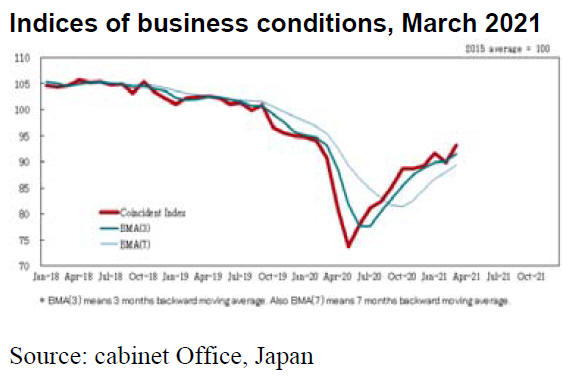
Big drop in household spending
The latest government data shows that year on year
household spending surged in March marking the biggest
single monthly gain in almost 2 years but this was not so
startling as it appears as spending in March 2020 tumbled
as the extent of the pandemic became known.
Data for April is not yet available but the new state of
emergency in the big cities and restrictions elsewhere
along with the slow and disorganised vaccination effort is
bound to drive spending down again.
Analysts forecast the Japanese economy will have fallen
into negative territory for the January-to-March period as
consumer spending, a significant driver of growth, was
impacted by the restrictions. Twelve research institutes
released projections ahead of the official GDP
announcement scheduled for18 May all estimate negative
annualised growth.
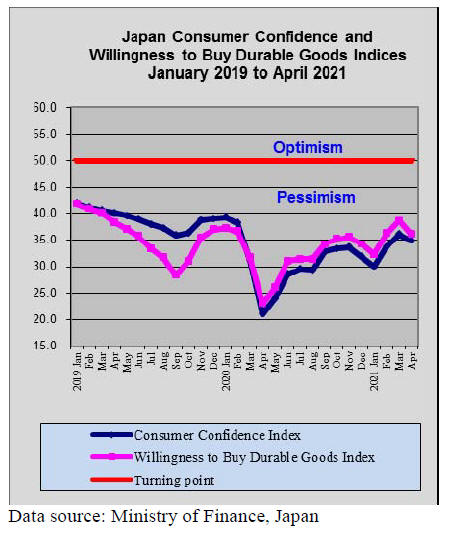
Early end to US stimulus would impact
yen/dollar
exchange rate
The US dollar firmed to over yen 109.65 in early May as
there were growing concerns over inflation in the US and
that this may signal an earlier than expected end to US
stimulus spending which was set to be wound down in the
final quarter of this year. Analysts now suspect this could
happen earlier.
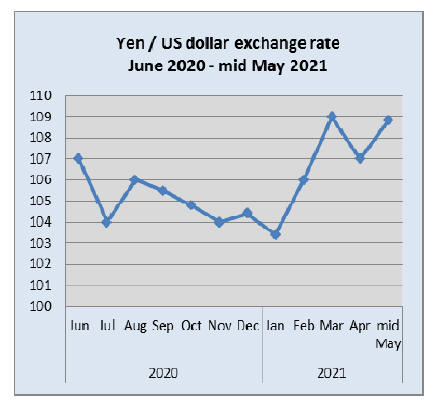
Fast widening income gap impacting housing
market
Economists in Japan talk of a K-shaped recovery to
explain parts of the economy are improving while others
are not and this is illustrated with house prices.
In Japan house and apartment prices in city centres are
rising, driven up by high income earners but have been
declining in outlying suburbs as middle and low income
earners are keeping out of the market or, for those worst
affected by the economic impact of the pandemic, even
having to sell their homes.
A fast widening income gap is emerging between highincome
earners and non-regular employees especially
those in the food and service sectors as such workers have
been the hardest hit by the loss of jobs and wage cuts.
While prices of expensive condominiums in urban centres
are rising but prices for inexpensive single-family homes
in outlying areas are falling as a result of weak demand.
Nationwide, average home prices over the past 6 months
fell 6% from a year earlier and home sales fell 14%
reflecting the impact of the pandemic.
See:
https://asia.nikkei.com/Spotlight/Datawatch/Japan-s-Kshaped-recovery-emerges-in-home-prices-amid-COVID-crisis
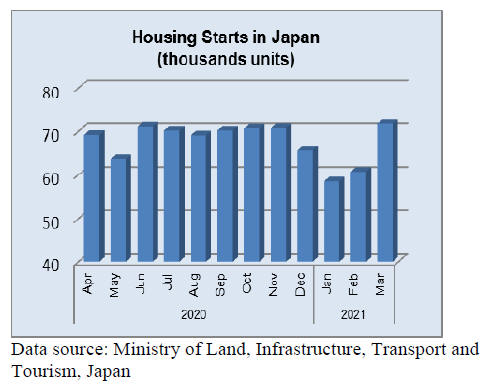
Import update
Wooden door Imports
Japan¡¯s first quarter 2021 imports of wooden doors
(HS441820) were up 5% on the same period in 2020 but
are still 20% below the value of first quarter 2019 imports.
In March 2021 manufacturers in China and the Philippines
provided most (87%) of Japan¡¯s wooden door imports
with manufacturers in Indonesia providing a further 5%
share of March imports. Shippers in China accounted for
62% of march door imports, up from levels in February.
Most of the balance was shipped from Europe and the US.
Year on year, March 2021 imports were 23% higher and
month on month there was an over 30% increase in the
value of wooden door imports.
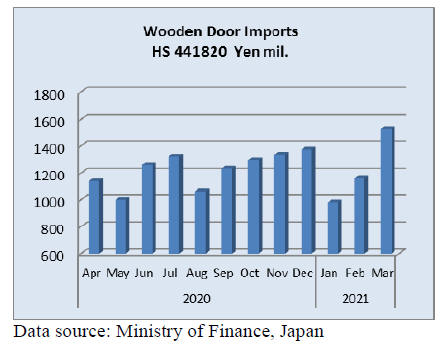
Wooden window imports
The value of Japan¡¯s wooden window (HS441810)
imports in the first quarter of 2021 was down 23% on the
same period in 2020 and down a massive 40% on first
quarter 2019 import values.
Year on year, March 2021 imports of wooden windows
were down 12% but month on month there was a 32%
increase in the value of imports. Three shippers, China
(46%), the US (24%) and the Philippines (15%) accounted
for most of Japan¡¯s wooden window imports in March
2021. The other significant shipper in March was Sweden
which accounted for around 9% of imports.
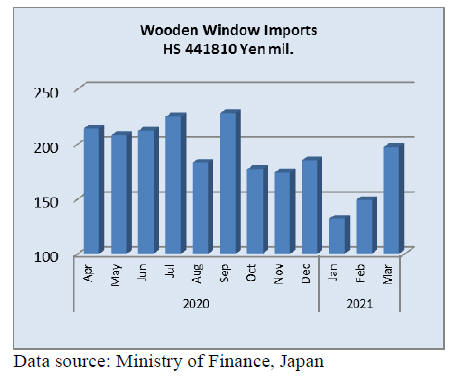
Assembled wooden flooring imports
The value of Japan¡¯s first quarter 2021 imports of
assembled wooden flooring (HS441871-79) was down 7%
compared to the same period in 2020 and 2021 imports
were 5% below that in the first quarter 2019.
Almost 60% of flooring shipments were of HS441875
with most coming from China and Malaysia.The second
largest category of wooden flooring was HS441879 which
accounted for just over 30% of all wooden flooring
imports. In this case, Indonesiaand the US were the main
suppliers.
Year on year, the value of Japan¡¯s imports of assembled
wooden flooring (HS441871-79) fell 7% and month on
month there was a similar 7% decline in the value of
imports. The March decline in flooring imports ended the
4 months of steady increases in the value of imports.
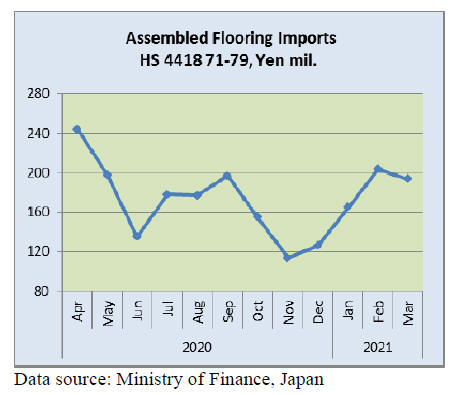
Plywood imports
Japan¡¯s first quarter 2021 imports of plywood (HS441210-
39) were down 8% on the same period in 2020 and were
down 11% on the volume of first quarter 2019 imports.
After a sharp drop in the volume of plywood imports in
February there was a correction in March which saw the
level of imports jump over 30% compared to February
with most of the increase being the result of higher
shipments from Malaysia, up almost 70% on February
shipments. Shipments of plywood from Indonesia, the
second largest shipper in March also increased but
shipments from Vietnam and China each declined in
March compared to levels in February.
Of the various categories of plywood imports HS441231
accounted for 91% of March 2021 imports with
HS441234, the second highest category.
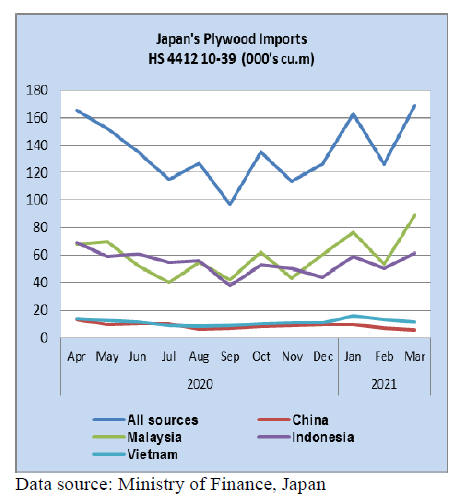
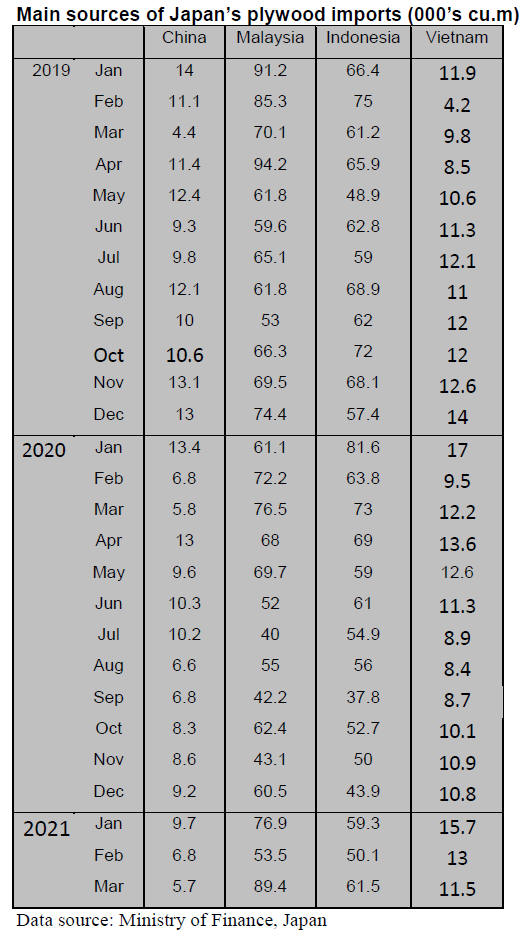
Trade news from the Japan Lumber Reports (JLR)
The Japan Lumber Reports (JLR), a subscription trade
journal published every two weeks in English, is
generously allowing the ITTO Tropical Timber Market
Report to reproduce news on the Japanese market
precisely as it appears in the JLR.
For the JLR report please see:
https://jfpj.jp/japan_lumber_reports/
A third wood shock hits Japan
The first wood shock in early 1990s was triggered by
environmental issues and the prices of imported wood
products soared. The second wood shock occurred in 2006
when Indonesia restricted timber harvests.
Now Japan is suffering the third wood shock with
unprecedented supply shortage and sky-high prices.
Reasons are demand expansion of the U.S.A. and China,
which push the wood products prices higher. Another
reason is shortage of containers, which causes delayed
shipments.
The extreme supply shortage dried up inventory in the
distribution channels and dealers are desperately looking
for substituting materials.
To supplement shortage of imported wood products,
demand rushes to domestic wood which market is
climbing fast. This is abnormal situation as there is no
products available regardless of the prices. One of major
precutting plants started reducing taking orders by 10%
since April because it realises that necessary building
materials are not available.
The Japan Laminated Lumber Manufacturers Association
warned that the manufacturers are facing extreme
difficulty to obtain lamina with unexperienced high prices
so the manufacturers may have to reduce the production
by 20% after May. One of major laminated lumber
manufacturers, Timberam has already taken curtailment
program since April with 25% lower production.
Market of structural laminated lumber peaked in 2018 then
it had kept falling. With COVID 19 pandemic, the prices
of whitewood laminated post were down to about 1,750
yen per piece and redwood laminated beam prices were
about 50,000 yen per cbm delivered but considering high
cost of lamina, redwood beam prices should be 80,000 yen
and whitewood post should be 2,500 yen per piece.
In the second half of last year, demand recovered steeply
in China and the U.S.A. while Japan market remained
dormant so purchase power by Japan dropped relatively.
As a result, offers for Japan declined.
Container shortage caused delayed shipments. This
delayed shipments for the suppliers. Even when the
cargoes are ready for shipments they sit at loading ports so
for the suppliers are now reluctant to look for containers
and ship for Japan.
Even loaded containers hung up at transshipment ports
like Shanghai and Pusan so Japan market runs out
inventory of imported wood products. Delayed shipments
mean order balances of suppliers increases then suppliers
reduce new offers.
In 2020, world economy seemed to stagnated by COVID
19 pandemic but China succeeded to contain corona virus
spread and the economy recovered steeply in the second
half of the year. The U.S.A. record low mortgage interest
rate and house quarantine stimulates housing market and
the lumber market shot up sky-high.
In short, Japan is left behind from world market. Not only
North American and European products but the prices of
log and lumber from Russia, New Zealand and Chile
soared after January of 2021.
New forestry basic plan
The Forestry Policy Council of the Ministry of
Agriculture, Forestry and Fishery discussed new forestry
basic plan. In this, total wood demand forecast in 2030 is
87,000,000 cbms, 5,000,000 cbms more than 2019 in
which domestic wood demand 42,000,000 cbms,
11,000,000 cbms more than 2019.
Measures to stimulate low reforestation are necessary and
to revise registration system of harvest and reforestation.
Present policy was approved by the Diet in May 2016.
Revised plan is made by May 2021, aiming approval of
the Diet in June after collecting public comments. The
plan is base to acquire necessary budget. Use of domestic
timber in 2025 of 40,000,000 cbms set by present plan is
unchanged then in 2030, the volume further increase by
2,000,000 cbms.
By use, 19,000,000 cbms for lumber, 6,000,000 cbms
increase. Judge in from the fact that the increase in five
years during 2014 to 2019 was only 1,000,000 cbms, this
target seems unrealistic. Total wood demand of
79,000,000 cbms in 2025 by the plan is surpassed actual
demand already so target in 2025 increased to 87,000,000
cbms. Increased demand is mainly fuel, which majority is
imported materials.
Therefore, percentage of domestic wood in total demand
would be 46% in 2025 and 48.3% in 2030. Present plan
estimates the percentage in 2025 is 50.6%.
For target of 2030, domestic wood supply is 42,000,000
cbms. Thinning is 450,000 hectares, 80,000 hectares more
than 2018. Reforestation is 70,000 hectares, 40,000
hectares more. Estimated number of workers engaged in
forestry in 2020 are 43,000.
Assuming the same number of workers is maintained in
2030, increased work load can be digested by improved
efficiency but it is doubtful that the same number of
workers can do reforestation and underbrush cleaning,
which areas are doubled from present base.
Actually, it is estimated that number of forest workers in
2030 would drop down to 38,000 so it is necessary to train
workers, who can do both harvest and reforestation.
Heating up of domestic lumber market
In Tokyo market, lumber market prices are abnormally
soaring. Supply shortage of everything of imported and
domestic wood products stimulate both actual demand and
speculative demand and large demand pushes the prices up
rapidly.
Particularly in auction market, where actual lumber is
available at the spot, bidders are swarming for limited
supply and 0n April 7, cedar post prices surpassed cypress
post at 80,000 yen, which is absolutely insane and
sawmills are asking buyers to calm down since this is
unwilling development. High prices do not increase the
supply volume.
In Tokyo market, lumber price increase has started since
last March since imported wood products decrease sharply
and the prices are soaring then things get hotter in April.
KD cedar 3 meter 105 mm post square prices are 65,000
yen and KD cypress 105 mm sill lumber prices are 75,000
yen. They are about 7,000-10,000 yen higher than March
and higher prices pop up in auction markets.
In auction market on April 7, auction started with 60,000
yen on 3 meter 105 mm KD cedar post square then
bidding shot up to 80,000 yen in short time. Successful
bidder¡¯s price of 3 meter KD cypress 105post square is
68,000 yen and 76,000 yen on 4 meter cypress 105 mm sill
square. Prices on others like green lumber are also
climbing largely.
In March, main purchase was speculative since everybody
thought purchase now before the prices go sky-high but
now purchasers actually need lumber now. Sellers are out
of control.
Meantime, precutting plants set the prices quarterly basis
for house builders so present prices on KD cedar post are
50,000-55,000 yen and cypress KD sill square are 60,000-
65,000 yen. It is certain that the prices jump up in next
round.
Log prices are also bullish and further increase is certain
toward rainy season.
Sudden increase of orders of plywood
There are increasing orders on domestic softwood
plywood in recent weeks despite demand slow season.
The manufacturers¡¯ plywood inventory has been very low
and in late March one plywood mill suffered fire damage
so that the production dropped.
From beginning of the year, demand for cedar logs has
kept growing due to short supply of imported wood
products so that cedar log prices climbed steeply.
Many plywood mills will stop the operation for about
ten
days for maintenance of the mill when there are series of
holidays in early May.
Plywood manufacturers proposed higher price of 950 yen
per sheet delivered on 12 mm 3x6 panel since April 1
because of high cost of cedar logs and tight inventory.
Precutting plants were inattentive to plywood supply in the
first quarter since precutting orders were slow despite
sharp drop of supply of North American and European
wood products in January and February. Plywood
manufacturers have been taking production curtailment
program to avoid excess supply so the inventory at the end
of February was 103,000 cbms, only 0.4 month of normal
monthly shipment.
Demand for domestic logs climbed to replace short
supplied imported wood products so the demand increased
all over Japan and log prices increased by 20%
everywhere. In particular, log prices are very firm in the
Western Japan, where stock of cedar is relatively low so
every users scramble cedar logs. On March 20, one
plywood mill in the Eastern Japan had fire accident and
the production will be less in April.
Now precutting plants started worrying about possible
supply shortage of plywood like imported products so they
are hurriedly procure plywood before thing get critical as
demand busy season is approaching.
South Sea (tropical) logs
South Sea log market in Japan is quiet. After major user of
South Sea logs stopped the operation, log demand sharply
declined and other log users are switching to use veneer
instead or other planted species. Lumber demand of South
Sea species is also stagnating as demand like truck body is
not active.
Chinese made laminated free board prices are climbing as
prices of raw materials like Russian red pine and New
Zealand radiate pine are climbing. Indonesian mercusii
pine free board prices are also climbing but the demand in
Japan is inactive so once purchase activities slow down,
upward move by the suppliers may simmer down.
There is some demand for natural wood decking of South
Sea species but the volume is very small.
Price increase of decorative plywood
Base board of decorative plywood is South Sea hardwood
thin plywood mainly from Indonesia. The supply of
Indonesian plywood has been declining and the prices are
soaring. There is no possibility of recovering and the
supply shortage may become critical in June.
Daishin Plywood in Niigata stopped the operation and one
of Indonesian plywood plants lost JAS qualification.
These two make supply situation much worse.
By prolonging supply tightness and continuous climb of
prices of thin plywood, base board is switched to MDF
and particleboard but 40% of decorative plywood base is
thin plywood from Indonesia yet. There are other base
board like domestic softwood and planted species but
there is strong demand of South Sea plywood for moisture
resistance.
However, shortage of South Sea plywood is critical now a
days. Price of South Sea plywood base product is almost
double of MDF base product. 70% of the cost of
decorative plywood is base board. 2.5 mm 3x6 plywood
prices are 25% higher than April last year and it would be
nearly 40% by May.
Marutama Plywood in Hokkaido raised sales prices of
decorative plywood by more than 10% since April 21.
Sumitomo Forestry Crest Co., Ltd. (Nagoya) raised the
prices by 10-20% since March. Kutok Corporation
(Osaka) will increase the prices by 15-20% since May 21.
Marufuji Kenzai (Saitama Prefecture) consider higher
prices since May.
Loss of Daishin Plywood is big blow for the
manufacturers as Daishin used to produce small volume of
special size products. There is no other plywood mills
doing such custom order manufacturing. Switching to
MDF base board will progress more but MDF¡¯s cost is
also getting higher due to higher import wood chip and
adhesive.
Tie-up for utilisation of domestic wood
Three house builders tie-up and formed Japan Wood
Housing Association to promote using domestic wood.
Sanei Architecture Planning Co., Ltd (Tokyo), Open
House Co., Ltd. (Tokyo) and KI-star real estate co., Ltd.
(Saitama prefecture) are collaborating to change building
materials from imported materials to domestic wood.
Three companies are builders of unit built for sale.
Purpose of the Association is supply of high quality house,
preservation of forest by using domestic wood and build
system to supply domestic wood products stably in
volume and price.
Sanei will build about 2,000 units in 2021 and switch all
the building materials to domestic wood products since
May. Post is cedar laminated, beam is larch laminated, sill
is KD cypress, stud and brace are KD cedar and taruki is
cedar LVL. KI builds about 4,000 units built for sale and
percentage of domestic wood is about 70%. Since April, it
plans to build 100-200 flat ordered units with 100%
domestic materials.
Open House supplies mainly three stories units, which is
difficult to use all domestic wood in terms of strength so it
will change to two stories units. It builds about 9,000 units
a year and 20-30% will be two stories unit.
Handling of domestic wood differs by the company so
each will try to change to domestic wood in possible parts.
The group¡¯s annual wood consumption is about 33,000
cbms and it is considering to plant trees in the North East
Japan to establish cycle of planting, nursing, harvesting
and use of planted wood.
|